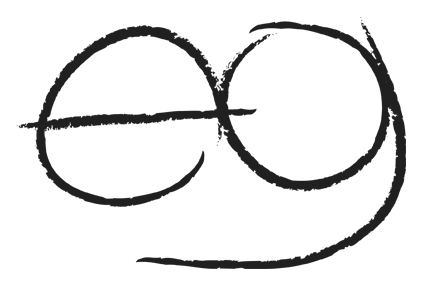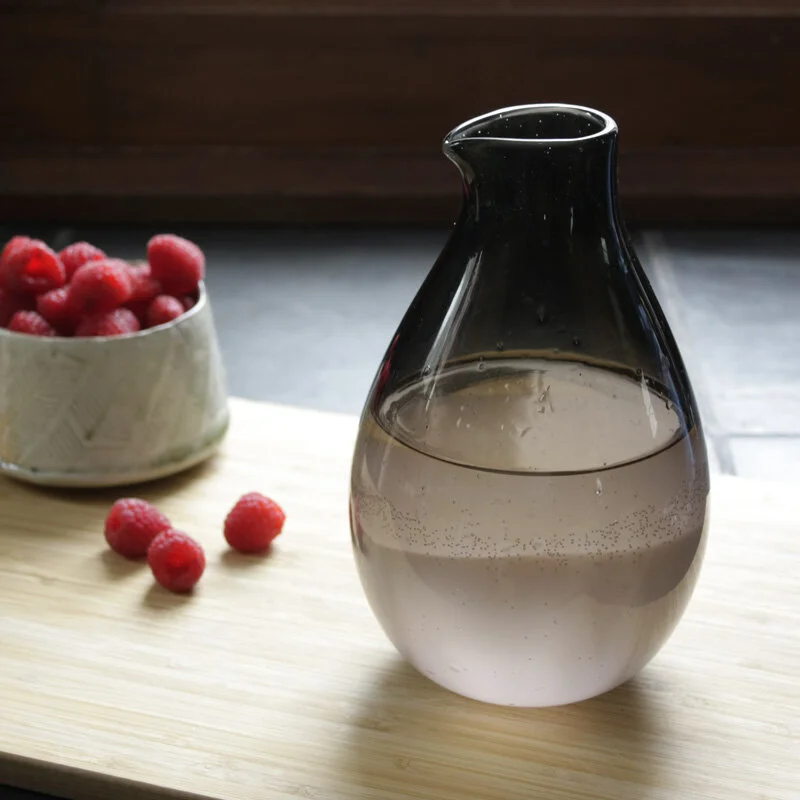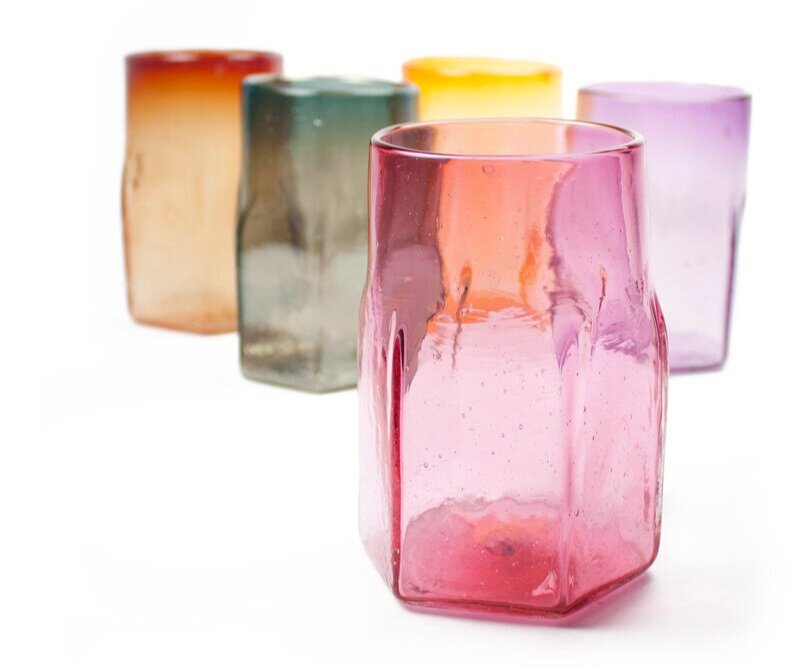I am so delighted to introduce Kate Civiero of Infinite Glassworks. Not only does Kate make gorgeous glass wares for everyday use, but she makes some incredible work out of copper as well. Her Avian series is particularly stunning. She has fun with everything she does and sometimes she even lets her chickens decide which colours or which optic mold she is going to use that day (follow her on Instagram for some of this solid content, you will not be disappointed!)
If you are interested you can experience the magic of molten glass yourself because Kate teaches classes out of her studio in Eugenia, Ontario! Nothing will give you a greater appreciation for glass art than trying it out for yourself, so bring your sense of adventure to Grey County and try something new!
What does handmade mean to you?
In my mind, handmade is a thoughtful, deliberate and skilled intersection between material, process, design and creation. It’s fun to own beautiful things, and there is significant value in owning an object designed and made by an artist. The look and the feel of handcrafted objects enhance our interaction with them. I design objects that emphasize functionality as well as aesthetics. Connecting visually with a handmade object is important, but using it and interacting with it is paramount. Handmade pieces have a way of becoming intertwined in our lives; there is something inherently special about owning an original, human-made object.
How long have your been working in your chosen medium? Did you attend college or university to learn your craft?
I graduated from the Sheridan College glass program in 2002 and since then I’ve been a self-employed glassblower in Grey County (2 hours north of Toronto). I formed Infinite Glassworks in 2005 with my husband Matthew and we spent many years renting time at various studios before building our own studio in our backyard barn in 2016.
Tell me about your process. What would surprise people about your process? Is there a part of your process that you don't enjoy?
My production work in glass focuses mainly on functional glassware using 2100ºF molten glass. I think the pace of glassblowing is something that often surprises people about the process. As glassblowers we use tools, heat, inflation, motion and gravity to shape the glass, all the while making split second decisions about its aesthetic outcome. The speed and fluidity and constant motion are some of the cornerstones of glass making.
There’s not really any part of working with glass that I don’t enjoy, I even get satisfaction out of cold working (grinding and polishing glass when it’s cold). There are good days and bad days in the studio and a bad day of glassblowing is always better than a good day of working at a job I don’t love. I try and keep that perspective on days when glassblowing feels like more like a grind and less like a party.
What about your chosen medium(s) made you pursue your craft?
Looking back, it seems crazy to have pursued hot glass without ever having worked with glass before I went to Sheridan (though I think that’s a very typical experience in the program). To be perfectly candid, glass was always a struggle for me in those years. I was young enough to be stubborn about it so I stuck with glass, but I don’t think that I necessarily had a natural talent for it. What I did have was an inner conviction that making objects by hand was something that I wanted to pursue, and that even if I lacked the technical skills to make really challenging pieces, I could keep pushing to create objects that were well-made and thoughtfully designed. Over time with practice and repetition my technical proficiency in glass grew to become aligned with my design capabilities.
If you could work in any other medium, what would it be?
I already relentlessly pursue other mediums when they pique my interest so if anything I probably should be exploring fewer mediums! I like to integrate different materials with my glass work, and I often find myself quite deep into processes that draw parallels to working with glass (blacksmithing, metalworking and ceramics). Lately, I’ve been diving deeper into metal forming techniques such as sinking and raising two dimensional sheet metal into three dimensional vessel forms. So much hammering!
What is the most important thing you want people to know about your work?
Making is not solely about technical skills and manipulating a material with your hands. I want people to know that I put literally everything I have into making objects: my heart and soul, my blood, sweat and tears and most definitely all of my mental, physical and emotional energy. I do it for the thrill, I do it for the challenge and I do it because creating is inside me. It’s what I’m good at and it’s what I was born to do. I wake up in the morning thinking about making and every night I go to bed thinking about making. It’s not just a job to me (and if it was, it’s not a get rich quick scheme by any stretch) but it is a way of life, and one that I have consciously chosen. I don’t have the luxury of working when inspiration strikes so I treat making as a job and I put in the time and work. I make when I’m full of ideas and the creativity is flowing and everything comes easy, and I make when nothing works and I feel tired and depleted and everything I create seems terrible. I show up for making every single day of my life and I get rewarded over and over again with amazing objects that I am proud of putting out into the world.
What is your greatest accomplishment, or the thing you are most proud of achieving with your art?
My greatest accomplishment is building my own glassblowing studio on my rural property. It’s no small feat (or expense) to build a glassblowing studio and it has unlocked some pretty awesome things. It’s the catalyst for being able to support myself with my art and has allowed me the opportunity to teach glassblowing and metal smithing. On top of that, it’s given me time to devote myself to making and pushing myself in directions that I wasn’t able to do while renting studio time. I have grown more as a maker and as an entrepreneur in the last 3 years of running my own studio than I have in the 15 years of renting studio space.
What has been your biggest challenge while pursuing your art?
One of the biggest challenges while pursuing my art is finding ways to untangle my ego and separate it from the work I make. I think that it’s a very difficult thing for any creative, not just makers. With each object I make, I put a little piece of myself out there in the world, and at times that can stir up a lot of emotions, both positive and negative. So many of these feelings I have are wrapped up in how others perceive my work and how they do or don’t validate it. When I’m less confident in what I’m making I tend to base validation on whether or not an object sells and this can be toxic for creativity and innovation. I’m trying to be more mindful of this tendency within myself to look at sales as validation and remember that gratification in making comes from within. Sometimes I just need to get out of my head and create something for the pure thrill of making it!
Has the confusion surrounding the term "handmade" affected your business/practice? What are your thoughts on re-sellers?
It’s a murky word, and peeling back layers of meaning and labeling an object as handmade, human-made, assembled, fabricated or manufactured can frankly be quite confusing to consumers. Overall, I get a sense that most people understand the core concept of handmade and that it is generally a positive attribute. However, because there are so many fake handmade products and re-sellers flooding the marketplace, it can be very misleading to people wishing to purchase an original handmade piece. Re-sellers and knock-offs are absolutely diluting the term handmade, and unfortunately the responsibility is primarily left to the makers themselves to educate consumers on the difference between authentic handmade and imitation handmade.
How do you (and how can we) educate consumers about what handmade actually means?
My favourite way to educate consumers is to get them out to my studio so they can see first-hand what it takes to make something by hand. When people see the 2100ºF molten glass and experience how physical, hot and tenuous glass making is, it opens up a dialogue about handmade and well-made objects and their place in our lives. I love chatting with people about different ways of making and the contrast between handmade objects and manufactured objects. There are nuances in the term handmade and there are nuances in the term manufactured and both have their merits and place in the marketplace. I think it’s important to not necessarily say one is good and one is bad, but instead teach consumers to spot the differences so they have the tools to make educated decisions about what they are purchasing.
How has being an artist changed the way you shop?
More and more I’ve been avoiding buying certain things because I feel that I can make them myself. This seems to be in direct relation to the technical fluency I’ve been acquiring in other materials. Obviously I make the glass objects in my home instead of buying them, but now I have access to making things out of metal, clay, wood and even textiles that in the past I would have had to purchase. When I do shop, I tend towards buying things that are made of natural materials and don’t contain much (if any) plastic. I look for well-designed things that are higher quality. I shop from small local businesses whenever possible, and I love buying from other independent makers, designers and craftspeople.
Who are your favourite makers?
I’m representing my rural roots here because the community of makers within Grey and Bruce County is a force to be reckoned with. Over and over I am inspired and in awe of the creativity, resilience and ingenuity of the humble folks making a living with their hands outside of urban centres. We truly have world class artists and craftspeople living on farms and back roads throughout our area, and they are some of the most humble people you will meet. Marcelina Salazar (ceramics) encourages me to constantly consider the relationship between function and form. Dano Harris (blacksmith) has shown me you don’t need a fancy studio or the best equipment to make innovative things. Becky Comber (photo based collage) has taught me the art of patience and tenacity in the creative process. I’m super lucky to have found a local community of makers, artists, craftspeople, farmers, chefs and creatives that I look to for support, inspiration, encouragement and even just to hang out and share a beer with.








